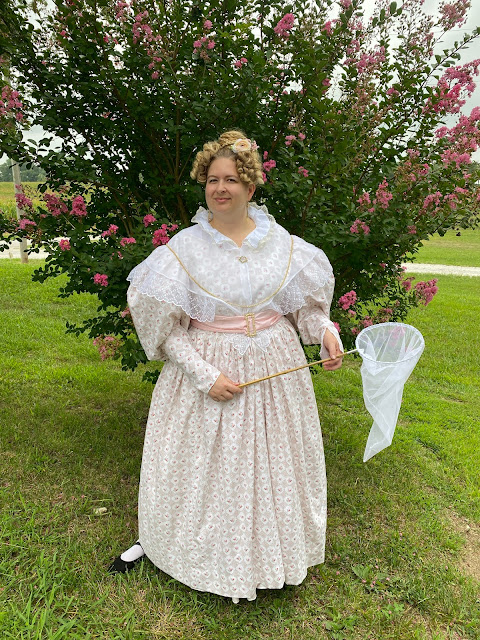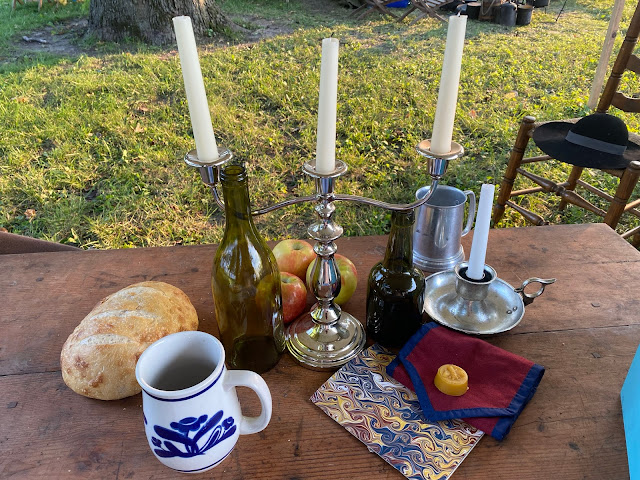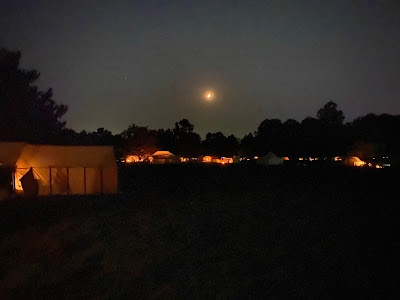After several enjoyable chats with acquaintances about our shared love of research and why it appeals to us in the context of historical fashions, it occurred to me that it's probably been many years since I thought about posting a little recap of my studies in local history. I have photographed a lot of my historical clothing at these places, and am always trying to read and learn more about them!
I feel very lucky as a former avid history major to live in a unique section of the United States -- a narrow corridor along the Mississippi River, far from the comfortable clusters of early colonial cities along the Eastern Seaboard, out in what was considered "the wild" by the more 'refined' English colonists. It has both a rich indigenous and early French colonial history that provides so much room for research and exploration.
My area of the French Illinois Country (which reached from Lake Michigan down to Louisiana, and in fact this area was sometimes also referred to as "Upper Louisiana") consists of a cluster of 18th century villages or settlements along either side of a small stretch of the Mississippi River : Cahokia, Prairie DuPont, St. Philippe, Fort de Chartres, Prairie du Rocher, Ste. Genevieve, Kaskaskia, and eventually St. Louis, and Old Mines, one of the last places that a unique form of French was spoken among the residents. People today are trying to revive the dialect through classes. The French came to this area for trapping and mining, but (unexpectedly to them) became probably the most useful to the Illinois Country as farmers.

The American Bottom along the western edge of these few counties was, for many centuries, possibly some of the richest and most fertile dirt in the world, thanks to the nearly annual floods and nutrient deposits from the then-unchecked Mississippi River (now banked by an extensive levee system). Many of us locals still like to drive along the road beneath the high stone bluffs and look out towards the Bottoms at the almost-black soil when it's turned over by today's farmers.
(photo of our steep rocky bluffs and the fields below from our local nature preservation society, Clifftop Alliance)
Cahokia was a settlement long before Europeans arrived, being a vast site of Mississippian Native culture from roughly 600-1350AD, and is one of only 24 UNESCO World heritage sites in the US. It was remarkably large and could have hosted around 20,000 occupants.
(an envisioning of what the huge main complex at Cahokia Mounds might have looked like in its heyday,
from the official website)
The series of earthen mounds are extremely impressive when considering
the dirt all had to be moved by hand, likely in woven baskets. However,
after a series of floods (always a hazard in this area to this day!) and
possibly other factors like the beginning of the Little Ice Age, the
original tribe abandoned it and the many mounds in surrounding areas (including downtown St. Louis, where mounds from the culture were razed in Forest Park for the 1904 World's Fair). For several centuries other
tribal peoples ebbed and flowed through the Mississippi Bottom.
It was in zealous hopes of proselytizing the Cahokia and Tamaroa tribes that the first French priest established a mission at Cahokia around 1696. By the mission's own account anyway, they were successful in converting some of the tribal peoples, particularly women, and they negotiated binding marriages in hopes of settling some of the voyageurs already traveling up and down the Mississippi with their furs and goods. Previously these trappers were only taking the Native women in temporary concubinage prior to the mission's establishment, encouraged by the tribal leaders as an aspect of trade, and decried by Catholicism as immorality. Kaskaskia, the settlement farthest south in the cluster, was founded shortly after Cahokia in 1703 with similar hopes, and the first Fort de Chartres was erected a distance north of Kaskaskia in 1720. Nearby Prairie du Rocher began in 1722. The first Fort de Chartres...and second...and third (all wooden) either flooded or fell into disrepair, and the fourth and final iteration was built in stone instead, begun in 1753.

France never committed to fully settling the area, half-heartedly sending some soldiers, petty criminals, and a few shipments of women from poor parts of France. Several waves of French Canadiens comprised a good chunk of the early settlers of the villages as well. Some were engagés, akin to the English idea of an 'indentured servant,' and worked their way under a wealthier trade or landowner for a set number of years, upon conclusion of which they were free to go their own way (and were sometimes set up with land or a small house and goods by the person they were working for). There was a smattering of other European nationalities; an Italian man, a few Spaniards, some Swiss, one or two from Holland, a woman from Germany, perhaps others, as some records have been lost.
A significant contingent of those living in the area were the enslaved Africans, many brought by Philippe Renault in his hopes of mining for silver across the river (all he managed to locate was lead) but others were in bondage to wealthier families, generally forced to work in agriculture. Ironically, the Jesuits were the largest slaveholders in the Illinois Country, with their mills and plantation lands. Under the Code Noir in place under French rule, enslaved Black persons were allowed to conduct some business on their own time, and some were able to buy themselves out of enslavement or were released in wills on the death of an enslaver, so some free Blacks also settled and did business in the area. A few enslaved Blacks also liberated themselves by running away to the local indigenous tribes and were presumably assimilated.
The French, unlike the English, saw the mercantile value of staying on good terms with several of the local tribes; there were Native villages very close to the towns, and tribal peoples came and went freely in and out of the French villages for trade. The French bought Native peoples off the tribes who had initially enslaved them (generally women captured in inter-tribal skirmishes) so there were also Native persons toiling in the house-gardens and serving in the homes...sometimes under a fully Native or metis (mixed) mistress who herself had married a Frenchman, though by the second generation, a good number of the prominent men in the French community were technically metis as well.
The melting-pot nature of these settlements would have been colorful and diverse, though this is not currently well-represented at large-scale local reenactments yet.
The later English and particularly the individualistic American settlers could not fathom why the French wanted to live clumped together in villages with their farmland extending outwards in long, skinny strips (some of which are still obvious on modern county plat maps). But the French settlers were a communal people who loved any excuse for a festival, a Holy Day, a dance, a meal together...and had little desire to grab up thousands of acres of land or rough it alone, miles from your nearest neighbor, as the rugged Americans later prided themselves on. Amusingly billiards was also a popular pastime, if you can imagine such a refined game being played in these small settlements out in the middle of nowhere! Card games, on the other hand, could get rather cut-throat, with at least one dispute turning violent enough to be recorded in the Fort's judicial annals.

(a map from French Colonial Fort de Chartres: A Journey Through Time by Tom Willcockson, a small but excellent illustrated book I helped promote with displays in area libraries when it first came out. This shows the village of Chartres, none of which is still standing and some acreage of which has unfortunately since been lost to the river. The levee now butts directly up to what was the front entrance to the stone Fort de Chartres. A similar thing happened to the larger town of Kaskaskia, plagued by floods over many decades, eventually swept away entirely by catastrophic floods in April 1881 which altered the course of the river entirely by cutting through a sharp bend, and it left a small chunk of Illinois on the west side of the river.) 
The fertile nature of the soil meant that even though they were "indifferent farmers" (as one appalled visitor wrote in a letter of their unhurried practices) they still harvested remarkable quantities of grain to send with their furs down the river to New Orleans in Louisiana, which would have struggled to feed its population from its swampy ground. Then back up the river came goods as payment, requested by letter from the habitants, trappers, traders and merchants.
A new "suit of camleteen" for one man, silk ribbons for the ladies, colorful calicos. Though not exceedingly ambitious, the French colonists were making better profit in the Illinois Country than they could have back in the old homeland of France, where most of the land belonged to aristocrats and the cities were over-crowded. Ever keen on clothing, the French colonists had no qualms about robing themselves in the best they could afford (not surprising, since so much of 18th century European society revolved around how you presented yourself). Though there would have been zero cobbled streets, only dust and then muck when it rained, even so "embroidered shoes" (which would have been high-heeled) were on the must-have list as well. Inventories show men's hats trimmed with gold lace, colorful indienne (chintz) cotton which was often banned in France but easy to sneak through the port of New Orleans, and gowns and petticoats of silk taffeta. Most likely these fripperies were saved for church or parties, and harder-wearing linen and wool would have dominated everyday work-wear, along with wooden sabots (like Dutch clogs) which are surprisingly comfortable, and the souliers de boeuf (moccasin-like leather shoes).

To my knowledge there are no current extant sketches of local fashions until possibly Anna Maria von Phul in the early 19thc, so some inferences have to be drawn from both working-class French paintings (like those by Chardin) and the few sketches existing from other French colonies like Canada, which mostly seem to echo European clothing trends.
(Canadian Couple (c. 1750-1780) by Anonyme. Source: Ville de Montréal. Gestion de documents et archives.)
(Detail view of Genre Studies of Habitants and Indians, anonymous, c. 1780, Royal Ontario Museum © ROM. 969.37.2. I'm always amused by this because I made a blue striped work gown nearly identical to the one above before I'd ever seen this sketch.)No gowns from the early to mid-18thc era of local French settlement survive, to my knowledge, but the Missouri History Museum has a fragment of an indienne gown passed down through the venerable Chouteau family, and it is very in keeping with samples you find in 18thc merchants' books in its charm and complexity.
(The fragment resides at the Missouri History Museum and is dated ca. 1750. A "wedding gown" also in the Chouteau family and supposedly dating to 1789 is apparently too fragile to be taken out of its box to view, and I have not yet seen that item.)
At the loss of the French & Indian war, France was forced to cede its holdings on the East side of the Mississippi River to the English in 1763, and rather than live under their rule, many of the French colonists packed up and moved over to Ste. Genevieve across the river, and then up to what would become St. Louis. Prairie du Rocher was the exception to this -- a number of the townspeople refused to move, and to this day there are many of the original French family names still right where they started in a tiny town set up against the Illinois bluffs. It is the closest French settlement to me and I visit it fairly regularly, although Ste. Genevieve has more and better-preserved French colonial homes.
(The 'Creole House' in Prairie du Rocher - the oldest section on the right was built in 1800)
(The Melliere house also in town under family ownership, parts of which date to 1735...and most likely there are other early French homes hiding under 1970s asbestos siding and sheetrock. Fort de Chartres is just a few miles down the road from the town.)
I hope you've enjoyed this VERY brief overview of the history of this small section of Illinois; I spend a fair amount of my free time visiting parts of it and learning its complex history. If you're interested in further reading (and there is a LOT of it), listed below are a few of the many excellent books I've read that give further details of the lives of the indigenous peoples, the enslaved Africans, and the French habitants in this area and other parts of the Illinois Country.
French Roots in the Illinois Country : the Mississippi Frontier in Colonial Times. University of Illinois Press, 2000, by Carl J. Ekberg
History as They Lived It: a Social History of Prairie Du Rocher, Illinois. Southern Illinois Univ. Press, 2013, by Margaret Kimball Brown
Kaskaskia under the French Regime. Southern Illinois University Press, 2003, by Natalia Maree Belting
Lives of Fort De Chartres: Commandants, Soldiers, and Civilians in French Illinois, 1720-1770. Southern Illinois University Press, 2016, by David MacDonald
Stealing Indian Women: Native Slavery in the Illinois Country. University of Illinois Press, 2010, by Carl J. Ekberg.
Wild Frenchmen and Frenchified Indians : Material Culture and Race in Colonial Louisiana. University of Pennsylvania Press, 2013, by Sophie White
























































